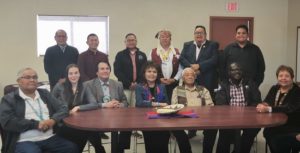Anishinabek Nation delegation visits the Navajo Nation to prepare for self-government

By Cindy Males
NIPISSING FIRST NATION— A delegation on behalf of the Anishinabek Nation made a quick visit to Arizona recently to learn more about how the Navajo Nation runs its government. Southeast Regional Deputy Grand Council Chief James Marsden led the team consisting of Chief Governance Negotiator Martin Bayer, Fiscal Relations Support Advisor Jidé Afolabi and Executive Assistant Mary Stock on the two-day visit to Window Rock, Arizona, capital of the Navajo Nation.
“When we met any of the leaders or even staff members of the Navajo Nation, they would introduce their clans first,” says Deputy Grand Council Chief Marsden. “They would introduce who they are, their clan and where they reside now, where their clan area actually was. So they follow that whole culture aspect of everything. I think that surprised us all. Every time we met someone, ‘I’m a part of this clan’, ‘My father’s clan’, ‘My mother’s clan…”
Chief Marsden believes Anishinabek Nation citizens will be able to do that too, some day.
“With more teachings. I told them a lot of people are still struggling to find out what their clans are just because of the residential school system, just the traditional history being lost.”
The proposed Anishinabek Nation Governance Agreement, between the Anishinabek Nation and Canada, formally recognizes the law-making authority of Anishinabek First Nations to strengthen language and culture, which will allow First Nations to reclaim the lost form of governance. It will also allow First Nations to decide who can be a citizen, who can run in their elections, and how their governments will be managed.
A citizen vote is scheduled for Feb. 1-29, 2020. As of Nov. 29, 2019, there are 28 Anishinabek First Nations that submitted a Band Council Resolution authorizing a vote in their community.
The proposed Governance Agreement also calls for the recognition of two levels of government— First Nations Governments and the Anishinabek Nation Government.
The governance negotiations team undertook the trip to examine the cost of operating a central government, the potential structure of that government as well as the potential role of that government.
“The Navajo Nation has much in common with the Anishinabek Nation,” says Fiscal Relations Advisor Jidé Afolabi. “Both have a high number of communities, and both are spread over a vast area. And to our benefit, the Navajo Nation has been operating self-government powers since the 1970s.”
The Anishinabek Nation represents 40 First Nations across Ontario that represents an approximate combined population of 65,000 citizens. The Navajo Nation is comprised of 110 “Chapters” with more than 200,000 people.
“The Navajo were quite hospitable and open. They operate a highly coherent form of government in which all parts are linked one to the other, with the result that the whole of government pulls in the same direction, and can attain objectives for citizens. The findings from the trip will be used to develop options regarding the organization of the new Anishinabek Nation Government.”
The Anishinabek Nation will host a Governance Summit in Jan. 2020 as it prepares to transition into the world of self-government after the citizen vote on the proposed Anishinabek Nation Governance Agreement.
“I look forward to their delegation coming here,” says Deputy Grand Council Chief Marsden on a Navajo Nation delegation being in attendance of the upcoming Governance Summit.

